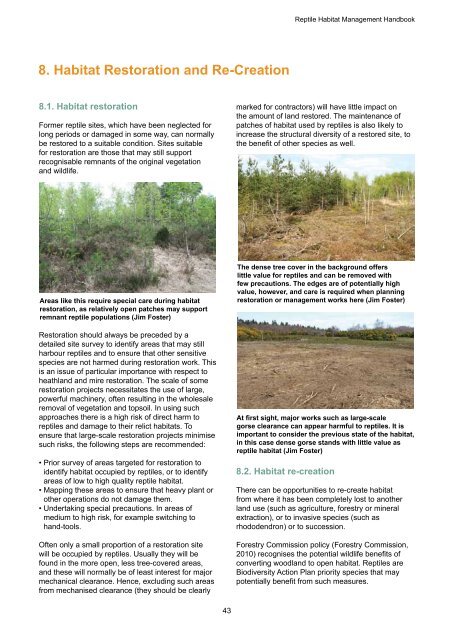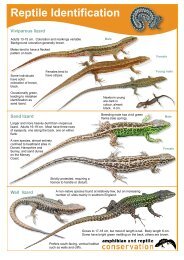reptile-habitat-management-handbook-ffull
reptile-habitat-management-handbook-ffull
reptile-habitat-management-handbook-ffull
You also want an ePaper? Increase the reach of your titles
YUMPU automatically turns print PDFs into web optimized ePapers that Google loves.
Reptile Habitat Management Handbook<br />
8. Habitat Restoration and Re-Creation<br />
8.1. Habitat restoration<br />
Former <strong>reptile</strong> sites, which have been neglected for<br />
long periods or damaged in some way, can normally<br />
be restored to a suitable condition. Sites suitable<br />
for restoration are those that may still support<br />
recognisable remnants of the original vegetation<br />
and wildlife.<br />
marked for contractors) will have little impact on<br />
the amount of land restored. The maintenance of<br />
patches of <strong>habitat</strong> used by <strong>reptile</strong>s is also likely to<br />
increase the structural diversity of a restored site, to<br />
the benefit of other species as well.<br />
Areas like this require special care during <strong>habitat</strong><br />
restoration, as relatively open patches may support<br />
remnant <strong>reptile</strong> populations (Jim Foster)<br />
Restoration should always be preceded by a<br />
detailed site survey to identify areas that may still<br />
harbour <strong>reptile</strong>s and to ensure that other sensitive<br />
species are not harmed during restoration work. This<br />
is an issue of particular importance with respect to<br />
heathland and mire restoration. The scale of some<br />
restoration projects necessitates the use of large,<br />
powerful machinery, often resulting in the wholesale<br />
removal of vegetation and topsoil. In using such<br />
approaches there is a high risk of direct harm to<br />
<strong>reptile</strong>s and damage to their relict <strong>habitat</strong>s. To<br />
ensure that large-scale restoration projects minimise<br />
such risks, the following steps are recommended:<br />
• Prior survey of areas targeted for restoration to<br />
identify <strong>habitat</strong> occupied by <strong>reptile</strong>s, or to identify<br />
areas of low to high quality <strong>reptile</strong> <strong>habitat</strong>.<br />
• Mapping these areas to ensure that heavy plant or<br />
other operations do not damage them.<br />
• Undertaking special precautions. In areas of<br />
medium to high risk, for example switching to<br />
hand-tools.<br />
Often only a small proportion of a restoration site<br />
will be occupied by <strong>reptile</strong>s. Usually they will be<br />
found in the more open, less tree-covered areas,<br />
and these will normally be of least interest for major<br />
mechanical clearance. Hence, excluding such areas<br />
from mechanised clearance (they should be clearly<br />
The dense tree cover in the background offers<br />
little value for <strong>reptile</strong>s and can be removed with<br />
few precautions. The edges are of potentially high<br />
value, however, and care is required when planning<br />
restoration or <strong>management</strong> works here (Jim Foster)<br />
At first sight, major works such as large-scale<br />
gorse clearance can appear harmful to <strong>reptile</strong>s. It is<br />
important to consider the previous state of the <strong>habitat</strong>,<br />
in this case dense gorse stands with little value as<br />
<strong>reptile</strong> <strong>habitat</strong> (Jim Foster)<br />
8.2. Habitat re-creation<br />
There can be opportunities to re-create <strong>habitat</strong><br />
from where it has been completely lost to another<br />
land use (such as agriculture, forestry or mineral<br />
extraction), or to invasive species (such as<br />
rhododendron) or to succession.<br />
Forestry Commission policy (Forestry Commission,<br />
2010) recognises the potential wildlife benefits of<br />
converting woodland to open <strong>habitat</strong>. Reptiles are<br />
Biodiversity Action Plan priority species that may<br />
potentially benefit from such measures.<br />
43



